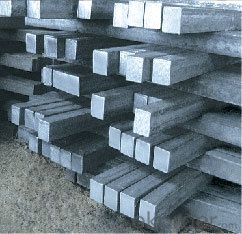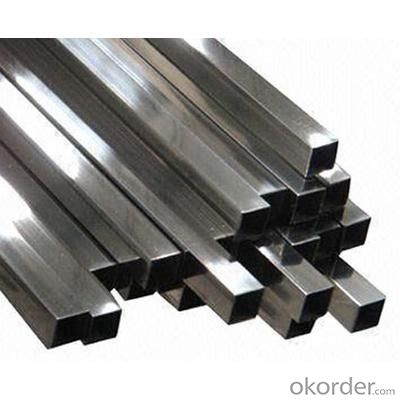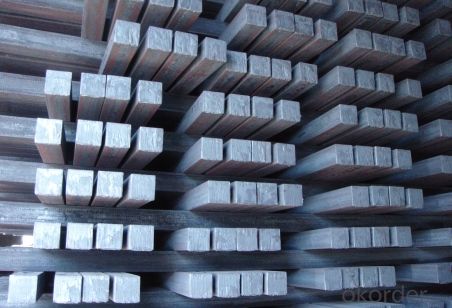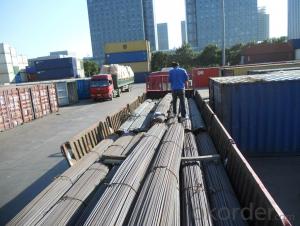Hot rolled steel square Bar for construction
- Loading Port:
- Tianjin
- Payment Terms:
- TT or LC
- Min Order Qty:
- 10000 m.t.
- Supply Capability:
- 100000 m.t./month
OKorder Service Pledge
OKorder Financial Service
You Might Also Like
Product Description:
OKorder is offering Hot rolled steel square Bar for construction at great prices with worldwide shipping. Our supplier is a world-class manufacturer of steel, with our products utilized the world over. OKorder annually supplies products to European, North American and Asian markets. We provide quotations within 24 hours of receiving an inquiry and guarantee competitive prices.
Product Applications:
Hot rolled steel Square Bar rare ideal for structural applications and are widely used in the construction of buildings and bridges, and the manufacturing, petrochemical, and transportation industries.
Product Advantages:
OKorder's Square Bar are durable, strong, and resist corrosion.
Main Product Features:
· Premium quality
· Prompt delivery & seaworthy packing (30 days after receiving deposit)
· Corrosion resistance
· Can be recycled and reused
· Mill test certification
· Professional Service
· Competitive pricing
Product Specifications:
the Hot Rolled Stainless Steel Square Bar is hot rolled, range from 5mm to 100mm,
Grade: Q195 Q235 and equivalent.
the monthly production capacity can be 500-1000 tons
it is used as structure steel.
the MOQ is usually 50 tons
canbe delivered by bulk vessel or by container.
STEXIN, an enterprise specializing in the production and sales of square bar, round bar and flat bar. The annual production capacity of square billet is 60,000 mtons, and sturtual steel 80,000 mtons.
FAQ:
Q1: Why buy Materials & Equipment from OKorder.com?
A1: All products offered byOKorder.com are carefully selected from China's most reliable manufacturing enterprises. Through its ISO certifications, OKorder.com adheres to the highest standards and a commitment to supply chain safety and customer satisfaction.
Q3: How soon can we receive the product after purchase?
A3: Within three days of placing an order, we will begin production. The specific shipping date is dependent upon international and government factors, but is typically 7 to 10 workdays.



- Q:How do you use a steel square to measure and mark 50.625-degree angles?
- If you wish to measure and mark a 50.625-degree angle using a steel square, you can follow these instructions: 1. Begin by ensuring that one side of your steel square has a protractor scale, which is usually marked in degrees. 2. Place the steel square on a flat surface, making sure it is stable and not wobbling. 3. Find the zero-degree mark on the protractor scale, typically located at one of the corners of the steel square. 4. Align the edge of the steel square with the line or surface where you want to measure and mark the angle. 5. Locate the angle measurement on the protractor scale that is closest to 50.625 degrees. Since steel squares usually have graduations in whole degrees, you may need to estimate and approximate the desired angle. 6. Once you have identified the closest angle measurement, make a small mark on the line or surface at the corresponding point on the protractor scale. 7. Use a straightedge or ruler to draw a line from the mark you made to the desired endpoint of the angle. 8. This line represents the 50.625-degree angle that you want to measure and mark. It is important to note that steel squares are not typically designed for measuring and marking precise angles with decimal places. They are commonly used for right angles (90 degrees) or other common angles like 45 degrees or 30 degrees. If you require a highly accurate measurement of a 50.625-degree angle, you may need to use a different measuring tool such as a protractor or a digital angle gauge.
- Q:What are some common applications for a steel square in tile installation?
- A steel square, also known as a framing square or carpenter's square, is a versatile tool that can be useful in tile installation. Some common applications of a steel square in tile installation include: 1. Checking squareness: A steel square is ideal for checking if the walls and corners are perfectly square. This is crucial in ensuring that the tiles are laid straight and in alignment. 2. Marking straight lines: A steel square can be used to mark straight lines on the floor or walls, which helps in guiding the installation process. It ensures that the tiles are placed evenly and in a neat pattern. 3. Determining tile layout: By using a steel square, you can easily lay out a grid pattern for the tiles. This allows you to determine the size and placement of each tile accurately, creating a balanced and symmetrical design. 4. Cutting tiles: When cutting tiles, a steel square can act as a guide to ensure precise and straight cuts. By aligning the square with the marked line on the tile, you can score and cut along the edge, resulting in clean and accurate cuts. 5. Creating a slope: In some cases, a steel square can be used to create a slope for drainage purposes. By tilting the square at a specific angle, you can determine the slope needed and mark the appropriate lines for the tile installation. Overall, a steel square is a valuable tool in tile installation as it helps ensure accuracy, straight lines, and proper alignment. It can save time and effort by providing a reliable guide for various tasks involved in tiling projects.
- Q:Can a steel square be used for checking the plumbness of poles?
- Yes, a steel square can be used for checking the plumbness of poles. A steel square is a versatile tool that is commonly used in carpentry and construction. It has a right angle shape, with a long blade and a shorter tongue, which allows for accurate measurements and checks for squareness. To check the plumbness of a pole, you can place the steel square against the side of the pole and ensure that it is perfectly vertical. By aligning the square with the pole, you can easily determine if the pole is leaning or not. The steel square provides a reliable and convenient method for checking plumbness in various applications.
- Q:Can a steel square be used for measuring and marking compound miter and bevel cuts?
- Yes, a steel square can be used for measuring and marking compound miter and bevel cuts. While a steel square is typically used for measuring and marking right angles, it can also be used to measure and mark angles for compound miter and bevel cuts. By using the measurements and angles provided by the steel square, you can accurately mark the cuts on your material before making them. However, it is important to note that for more precise and complex compound miter and bevel cuts, specialized tools like a miter saw or a bevel gauge may be necessary.
- Q:Can a steel square be used for checking the squareness of a door jamb?
- Yes, a steel square can be used for checking the squareness of a door jamb. A steel square, also known as a framing square or carpenter's square, is a versatile tool commonly used in carpentry and woodworking projects. It has a 90-degree angle and is designed to assist in ensuring accuracy and squareness in various construction tasks. To check the squareness of a door jamb, the steel square can be placed against the inside edge of the jamb, ensuring that the 90-degree angle of the square aligns with the corner of the jamb. By visually inspecting the alignment of the square against the jamb, any deviations from a perfect 90-degree angle can be identified. If the steel square indicates that the jamb is not perfectly square, adjustments can be made to ensure proper alignment. This may involve shimming or trimming the jamb to achieve the desired squareness. Overall, a steel square is a valuable tool for checking and correcting the squareness of a door jamb, ensuring a proper fit for the door.
- Q:How do you use a steel square to lay out a trapezoid shape?
- To use a steel square to lay out a trapezoid shape, you would first determine the desired dimensions of the trapezoid. Then, using the steel square's long side or blade, you would mark the length of one of the parallel sides of the trapezoid. Next, you would rotate the square and align its shorter side or tongue with the desired width of the trapezoid. Finally, mark the other parallel side of the trapezoid using the steel square. This process ensures accurate and consistent measurements for creating a trapezoid shape.
- Q:How do you use a steel square for marking stair tread and riser dimensions?
- To use a steel square for marking stair tread and riser dimensions, follow these steps: 1. Start by measuring the total rise of the stairs, which is the vertical distance from the top of the landing to the finished floor level. Note down this measurement. 2. Next, determine the desired height of each riser. This can be calculated by dividing the total rise by the number of risers. For example, if the total rise is 48 inches and you want 6 risers, each riser should be 48/6 = 8 inches high. 3. Now, take your steel square and place it on a flat surface. Position the long edge of the square vertically, ensuring it is perpendicular to the surface. 4. Align the bottom corner of the square with the edge of the material you are marking, such as a piece of wood or the stringer on the stairs. 5. With the square held firmly against the material, use a pencil or marking knife to draw a line along the inside edge of the square. 6. For marking the tread dimensions, use the inside edge of the square to measure and mark the desired depth of each tread. The tread depth can be calculated by subtracting the riser height from the desired total run (the horizontal distance covered by the stairs). For instance, if you want a total run of 72 inches and have 6 risers, each tread should be 72/6 = 12 inches deep. 7. Repeat this process for each riser and tread, ensuring that the square remains held firmly against the material to maintain accuracy. Using a steel square for marking stair tread and riser dimensions allows for precise and consistent measurements, resulting in well-balanced and safe stairs. Remember to always double-check your measurements before cutting or installing any materials.
- Q:Can a steel square be used for checking the squareness of a bookshelf?
- No, a steel square cannot be used for checking the squareness of a bookshelf. A steel square, also known as a carpenter's square or a try square, is primarily used for measuring and marking right angles in woodworking and carpentry. It is not designed to accurately determine the squareness of a complex structure like a bookshelf. To check the squareness of a bookshelf, a more appropriate tool would be a combination square or a framing square, as these are specifically designed to measure and verify right angles in larger structures. Additionally, a level or a measuring tape can also be used to ensure the bookshelf is level and accurately aligned. Using the correct tools for the task at hand is crucial to achieving accurate and precise results.
- Q:Can a steel square be used for marking out dovetail joints?
- The use of a steel square in marking out dovetail joints is indeed possible. In woodworking, a steel square is a versatile tool that is frequently employed to measure, mark, and verify the accuracy of right angles. Achieving precision and accuracy is paramount when marking out dovetail joints, and a steel square can serve as a vital reference for obtaining the correct angles and dimensions. By aligning the square with the workpiece's edges, it aids in guiding the marking of the dovetail angles and provides a straight edge for precise cutting. However, it is worth noting that, although a steel square is a helpful tool, it is advisable to complement its use with a dovetail marking gauge or a dovetail template to ensure optimal outcomes and consistent results throughout the project.
- Q:How do you use a steel square to measure and mark out crosscuts?
- To use a steel square to measure and mark out crosscuts, you would typically follow these steps: 1. Set up your workpiece: Ensure that the piece of wood or material you plan to cut is securely clamped or held in place on a workbench or saw horses. 2. Determine the desired crosscut length: Measure and mark the length you want to cut on the edge of the workpiece using a measuring tape or ruler. 3. Position the steel square: Place the steel square against the edge of the workpiece with the long arm of the square touching the edge and the short arm extending over the face of the workpiece. 4. Align the square: Adjust the position of the square until the long arm is parallel to the marked line on the edge of the workpiece. 5. Mark the crosscut line: Use a pencil or a sharp knife to mark a line along the edge of the steel square's short arm, extending across the face of the workpiece. This line will indicate the exact location of the crosscut. 6. Double-check measurements: Before proceeding with the cut, double-check your measurements to ensure accuracy. Make any necessary adjustments to the position of the steel square if needed. 7. Make the crosscut: Use a saw, such as a handsaw or a circular saw, to carefully cut along the marked line. Make sure to follow proper safety precautions and use the appropriate technique for the type of saw you are using. By following these steps, you can effectively use a steel square to measure and mark out crosscuts with precision and accuracy.
1. Manufacturer Overview |
|
|---|---|
| Location | |
| Year Established | |
| Annual Output Value | |
| Main Markets | |
| Company Certifications | |
2. Manufacturer Certificates |
|
|---|---|
| a) Certification Name | |
| Range | |
| Reference | |
| Validity Period | |
3. Manufacturer Capability |
|
|---|---|
| a)Trade Capacity | |
| Nearest Port | |
| Export Percentage | |
| No.of Employees in Trade Department | |
| Language Spoken: | |
| b)Factory Information | |
| Factory Size: | |
| No. of Production Lines | |
| Contract Manufacturing | |
| Product Price Range | |
Send your message to us
Hot rolled steel square Bar for construction
- Loading Port:
- Tianjin
- Payment Terms:
- TT or LC
- Min Order Qty:
- 10000 m.t.
- Supply Capability:
- 100000 m.t./month
OKorder Service Pledge
OKorder Financial Service
Similar products
New products
Hot products
Related keywords

























